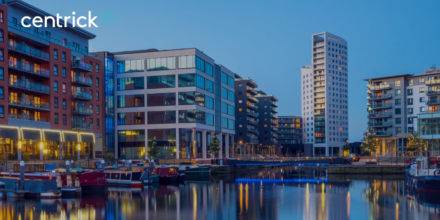Over the past decade, Build To Rent developments have become city centre staples. These developments offer premium living which is not just community-driven, but high-spec, convenient and brimming with impressive amenities – all without the commitment of a mortgage that could drain your savings. Our Director of BTR, Clare Johnson, explained:
Build to Rent in all its forms is incredibly important across the property landscape – it’s perhaps no surprise that as the rental demographic changes and the wider community demand a better quality of living that BTR is increasing in popularity with renters, developers and investors alike. As we look forward to the future BTR will become a cornerstone that cannot be overlooked
It’s no wonder that many young renters are choosing BTR schemes for their next home: but what does the future of the BTR landscape look like? VICI by Centrick investigate the future of the BTR landscape, and the importance of this progressive rental format in years to come.
BTR in 2024
The Build To Rent sector is already exceptionally popular, and is currently stronger than it ever has been. This newer, more community focused, format of renting has, in many ways, been beneficial in mitigating some of the impact of the housing crisis, which has seen far more searching tenants and buyers than available properties, ostensibly by creating comprehensive, rental friendly developments in key locations. £3.2 billion of capital was spent in 2022 alone on BTR investment, representing a 10% increase from the year prior, according to Knight Frank’s Multihousing Report. This impressive year-on-year growth and capital backing from major investment funds continues to make BTR one of the most promising property sectors, with the future of BTR looking bright.
Growth and Expansion
The rental market has proven its resilience, especially against the backdrop of rising property prices and the halting of the Help To Buy scheme which whilst it has been replaced in part by other schemes, including First Homes, goes little way to filling the gap for many first time buyers. This makes demand for rental property reliably high, making investment in the future of BTR a sensible option for many large-scale developers. In fact, a recent Multi Housing Report indicates that by 2028 the estimated capital committed to the BTR sector will be £102 billion and such developments continue to appear more frequently across the country. BTR is becoming increasingly common across the UK, with this trend showing no signs of stopping anytime soon. In fact, the number of completed BTR developments has tripled over the past five years – and this doesn’t even include developments in the pipeline or near completion. According to research, there are almost 200,000 individual BTR units either completed, close to completion, or in planning with estimates suggesting that completed BTR homes could reach 380,000 by 2032.
But why are developers and investors putting their faith in the future of BTR rather than the private rental sector? For this we may need to step backward to the Montague Report, published in 2012 in the midst of a not unfamiliar housing shortage. Sir Adrian Montague’s review suggested that the Private Rented Sector (PRS) was growing at pace and consisted of a much more diverse demographic than was widely recognised at the time. It also recognised issues in the quality of PRS stock, limitations in personal and commercial funding, and a disparity between the growth of PRS and supply of new housing. Montague also recognised the prevalence of what we now call BTR in other countries and called on local authorities as well as Central Government to “make more positive use of existing opportunities under the planning system to promote private rented schemes”.
Fast forward to 2023 – perhaps we have Montague to thank for accelerating the process and progress within the BTR property sector. Although a far newer – and in some cases unfamiliar – concept, BTR is beginning to outpace the private rented sector in terms of relative growth, with BTR properties showing an average annual growth of 3.4 per cent compared to the private rental sector’s 1.9 per cent (according to the ONS). It is therefore no surprise that many investors and developers are choosing to capitalise in the early adoption phase of the BTR lifecycle and take advantage of such impressive growth.
The growth of the sector is perhaps unsurprising, given the gulf between the quality and availability of the “product” that residents are comparing. We examine some of the key components that both residents and planners consider and just where the trends in BTR are set to land.
Energy Efficiency
Newer BTR developments are equipped with the latest technology, including energy efficient measures and tools to ensure optimal sustainability. With the existing energy crisis causing bills to soar, BTR developments with these upgraded technologies such as solar panels, air source heat pumps, smart thermometers and smart meters will become increasingly popular. The inclusion of these energy saving facilities, and the money they can help tenants save month-on-month, may also be able to counter-balance the often premium BTR rents.
As such, we anticipate that most build to rent schemes will market themselves with this focus on energy that doesn’t cost the earth nor the tenant. This bodes well considering the younger target demographic of many BTR schemes are generally more environmentally conscious. We’re already starting to see the push for Net Zero build to rent structures, with solar energy systems being implemented to heat homes and generate electricity. As sustainable technology develops, expect to see these take centre stage in BTR developments in a bid to appeal to the new, more environmentally conscious generation of renters.
Onto New Ground
BTR developments are especially popular in larger cities where rental demand is higher and individuals may have high-earning jobs, but not enough funds or savings to purchase a property outright, or may choose, as is more popular in mainland Europe, to adopt a rental model by choice rather than tie up capital or cede freedom of choice. However, BTR is not expected to remain popular in larger cities alone for much longer, with predictions indicating that smaller cities and large towns will benefit from build to rent developments in the near future. Industry commentators have noted that smaller cities such as Sheffield, Exeter and Cambridge are set to see an influx of BTR developments, which will surely benefit their broad resident student population. Graduates looking for jobs in the city, as well as post-graduate students that are both working and studying, will surely be attracted to the prospect of modern BTR developments with their readily available amenities and community focus to support their transition from student life to independent living.
The same can be said for regions with large projected population growth, with Norwich, Chelmsford and Peterborough expecting a population growth of at least 3.5 per cent by 2031. With these areas also having a population consisting of at least 40 per cent of people under 35 – the ideal target age for BTR developments – we anticipate a drastic increase in interest for BTR schemes in these areas. This could help mitigate strong population growth by providing ample housing opportunities whilst providing a viable alternative to the pressure of getting on the housing ladder.
Amenities
BTR developments are known for their vast range of state-of-the-art amenities that give residents unrivalled access and value for money by offering on-site services such as restaurants, cafes, gyms, convenience stores, pools… the possibilities are endless. But what can we expect to see more of in BTR developments, and which facilities will continue to be popular?
- Gyms are expected to remain popular, especially in the aftermath of the coronavirus pandemic where health has become paramount to many young people. The need for on-site gymnasiums and fitness facilities is also exacerbated by the fact that more people are working from home and are looking for more ultra-convenient options to stay fit
- Communal gardens are set to remain popular in BTR developments, especially as many tenants renting through BTR schemes have pets. The pandemic saw a sharp surge in the number of households adopting and purchasing animals, and having a private and safe place to take your dog for a walk without even leaving the parameters of your property development is the ultimate convenient option for tenants
- Communal on-site workspaces are set to become more important to BTR residents, especially considering the sharp uptick in energy prices. Many tenants and homeowners are choosing to work from libraries and cafes rather than from home in order to avoid using energy during the day – having an on-site workplace facility that is both convenient and functional without being too far from home will prove to be popular in 2023 and beyond
Interested in Build To Rent developments in the UK?
For over 18 years, Centrick have supported developers and investors to build high performing, engaged communities with our BTR expertise. We’ve combined our range of skills in assisting BTR developers to create the ultimate platform, VICI by Centrick. This comprehensive, end-to-end platform aims to assist developers and investors from the conception of their development through to the onboarding of tenants and management of their facilities – all under one roof.
Want to uncover the secrets of the build to rent market? Download our Love Where You Live brochure, our first-party research full of exclusive insights into the future of BTR. Get your free PDF by filling out the form at the bottom of the page.











